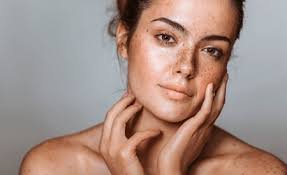Healing Hyperpigmentation On The Face And Body
Dark spots, or hyperpigmentation, are a common skin problem faced by a huge amount of the population. It’s not a condition or disease, it’s simply a term that is used to describe skin that is darker than normal for that specific person.
While it is indeed normal and widespread, and not usually anything to worry about medically, it can be annoying and even affect your self-esteem. Wanting to rid yourself of hyperpigmentation doesn’t mean you don’t love yourself or the way you look, it simply means you want to change your aesthetics to match what you want to put out into the world!
Dark Spots
It’s not a condition or disease, it’s simply a term that is used to describe skin that is darker than normal for that specific person.
WHAT CAUSES HYPERPIGMENTATION?
After a bout of acne or sun exposure, you might find yourself with hyperpigmentation. It can appear anywhere on the body, and there are a few different kinds of hyperpigmentation that can occur.
You are at a higher risk of hyperpigmentation if you:
Spend a lot of time in the sun especially without using or reapplying sunscreen
Have a naturally darker skin colour
Take certain medications, like contraceptives, chemotherapy, or medicines that make you sensitive to sunlight
Have an underlying condition that creates hyperpigmentation as a symptom
Hyperpigmentation
Hyperpigmentation is usually not indicative of any health problems, but rarely it can indicate Addison’s disease, acanthosis nigricans, Hemochromatosis, or a vitamin B12 or folate deficiency.
Post-Inflammatory
Post-inflammatory hyperpigmentation is the small dark spots left behind after acne or a wound (like a scrape, scratch, or burn) clears up and heals. Even if you don’t pick your pimples, you can, unfortunately, find that it has left a hyperpigmented spot.
While healing, the skin produces cells that simply have too much melanin in them, so the hyperpigmentation causes the appearance of a dark spot.
Sunspots
Sunspots aka liver spots aka solar lentigines are freckle-like dots that appear on the skin in places that receive the most sun, like the backs of the hands, shoulders, tops of the feet, chest, upper back, and face. Unlike freckles, they do not fade after a period of time without sun exposure.
They typically appear most in people aged 50 or older because they take time and repeated exposure to occur. In this case, they are relatively harmless and simply an indication of a life lived outdoors. However, if these spots appear extremely dark/black, grow in size after appearing, change shape, have irregular edges, one spot is multiple colours, or if they bleed, then you should see a doctor right away as that can be a sign of skin cancer.
Fun fact: these spots are called “liver spots” because it used to be thought that they indicated a poorly-functioning liver. Now we know that is not the case!
Melasma
This type of hyperpigmentation of the skin is caused by hormones. Typically, pregnancy hormones cause areas of the belly and face to darken in a specific pattern, called “linea nigra” and the “mask of pregnancy,” respectively.
Hormonal contraceptives can also trigger these types of melasma hyperpigmentation, but usually, they clear up over time and it’s not always necessary to stop taking the medication for the spots to disappear.
Certain medications can also cause melasma, such as:
NSAIDs
Tetracycline antibiotics
Phenytoin
Anti-malaria medicines
Amiodarone
Blood pressure medicines
Psychotropic medicines
HOW TO PREVENT HYPERPIGMENTATION?
Some instances of hyperpigmentation are unavoidable, like in the cases of hormonal melasma. You may be able to research dietary information about supporting your hormones, but as far as topical treatments, there isn’t much that can be done.
Other types of hyperpigmentation, sunspots and post-inflammatory, are greatly reduced with some preventive measures!
Wear Sun Protection
Applying sunscreen, wearing hats and sunglasses, covering up shoulders, and using a parasol are all great ways to protect the skin from the sun. Of course, moderate sun exposure feels lovely and is usually harmless, but repeated exposure without any SPF, for long periods of time, and which results in burns is asking for trouble.
Avoid Too Much Heat
For some, high temperatures- even without sun!- can be a cause of hyperpigmentation. Hot summer days, sauna, hot yoga, and even cooking can be a trigger for certain people’s skin. Notice if you tend to experience skin irritation due to high temperatures and limit your exposure where possible.
Exfoliate and Moisturise Regularly
Exfoliating is helpful to clear away dirt and excess oils, and it also helps break up formations of overly-melanated skin before it has a chance to become visible. The combination of gentle manual exfoliants like sugar, salt, and coffee grounds combined with chemical elements like salicylic acid work together to maintain an even skin tone.
Exfoliants also help reduce acne and encourage cell turnover so there is less of a chance of post-inflammatory hyperpigmentation to occur. But, be sure to use exfoliants gently and not too often, or you risk accidentally giving yourself post-inflammatory hyperpigmentation from micro-abrasive wounds!
Using moisturisers that protect your skin’s natural barrier is key to helping it stay strong against the sun and physical damage. You can also find moisturisers that contain vitamin c and other ingredients to help maintain an even skin tone.
Just be mindful that ingredients like salicylic acid and vitamin c can make the skin even more sensitive to the sun, so be extra careful to use SPF and cover up!
Nutrition and Hydration
Giving the body everything it needs to grow and maintain healthy skin is another way to ensure you remain luminous and clear of spots, dark or otherwise. You may even be able to manage some hormonal melasma with certain foods, but that varies wildly between individuals so be sure to do your own research!
Eat well and drink plenty of water to maintain skin health. Ask your doctor if any supplements like biotin might be helpful for you.
HOW TO HEAL HYPERPIGMENTATION
Even if you do everything possible to prevent hyperpigmentation, it will probably show up at some point. C’est la vie! There are a few ways you can help fade and heal your dark spots. Just have patience and stick to a routine.
Scrubs and Creams
As mentioned before, chemical ingredients mixed with the act of physically exfoliating the skin help break up overly-melanated skin cell clusters. They are absorbed into the body or shed as dead skin, giving new, non-hyperpigmented cells to grow in their place.
In your scrubs, exfoliants, and creams look for aloe, witch hazel, vitamin e (found in jojoba oil, sunflower oil, safflower oil, avocado oil, sweet almond oil), glycerin, citric acid, rosemary, astragalus, chamomile, propolis, gotu kola, wild geranium, dandelion, lavender, reishi, eucalyptus, tea tree, vitamin b5 (panthenol), white willow bark extract (salicylic acid), rosehip seed oil & meadowfoam seed oil (vitamin c), neem, pumpkin extract (AHAs), cocoa butter, shea butter, and green tea.
You can also seek specific skin-lightening hyperpigmentation creams, but note that these are really only effective at fading spots, not lightening your natural skin tone. They can also be too harsh for the skin and cause more harm than good, so if you feel you need something prescription strength talk to your doctor about the pros and cons of a strong treatment.
Chemical Peels
Glycolic acid peels and TCA peels can help strip off the layers of pigmented skin needed in order to reach a uniform skin tone underneath. However, they can be very harsh to the skin and leave it vulnerable to more damage for a period of time while recovering.
Retinols
Retinols are very strong, pure forms of vitamin a. They can help remove the damaged top layers of skin, but if you use them too frequently or incorrectly, they might end up doing more harm than good.
Laser Therapy
The laser’s wavelengths target melanin and break it up, causing it to rise to the surface of the skin and get removed with other dead skin. This is an effective treatment, but it can cause some pain, redness, and swelling as well as make skin appear darker until the melanin comes all the way to the surface. Your skin is also extra sensitive to the sun while recovering.
Prescription Medication
Certain medications can treat severe hyperpigmentation, especially melasma-type. These medications include:
Hydroquinone
Arbutin
Alpha hydroxy acids
L-cysteamine
Tranexamic acid
Of course, the medication you take will depend on many variables and each may have its own side effects.
When it comes to hyperpigmentation, you have lots of options for preventing and treating spots!





